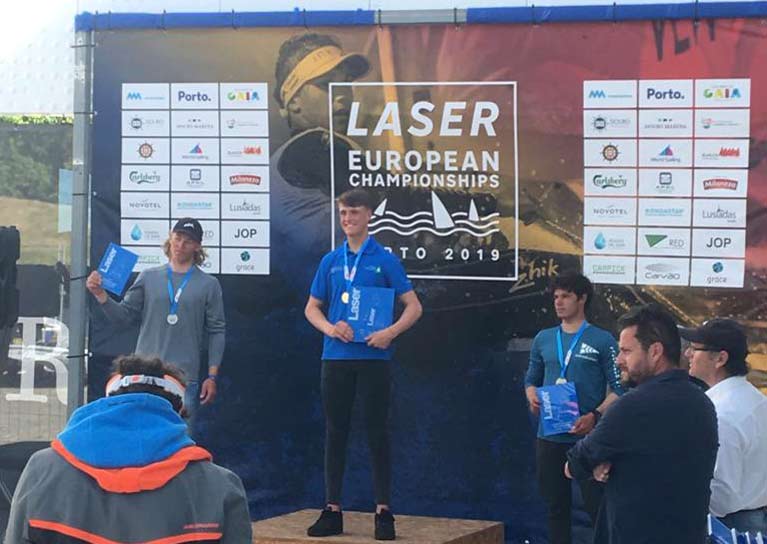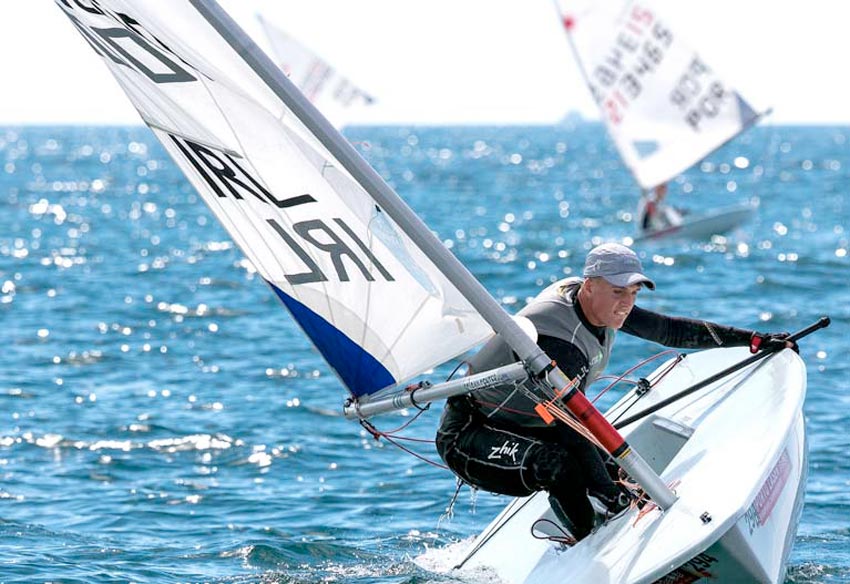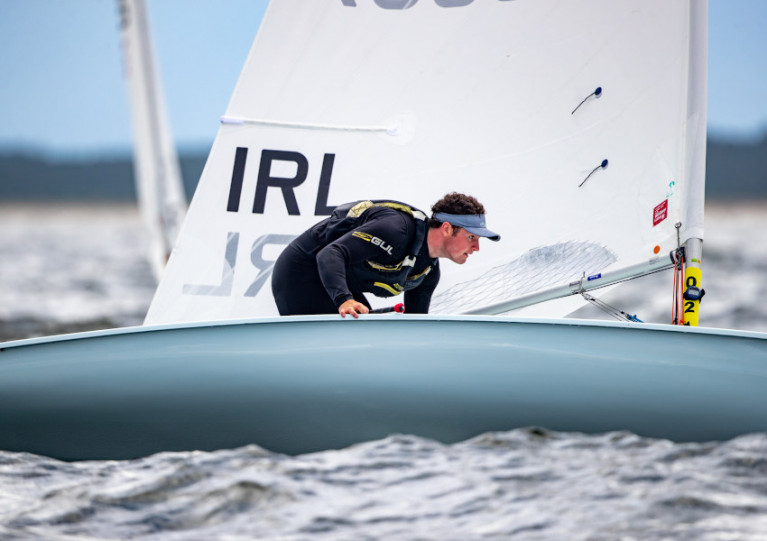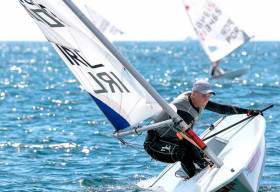Displaying items by tag: Laser Europeans
Personal Best For Liam Glynn At Laser Europeans In Poland
Ballyholme Yacht Club’s Liam Glynn has secured a personal best and 43rd overall after six days of racing against 126 international competitors at the Laser European Championships in Gdansk, Poland.
Northern Ireland sailor Glynn, who had been unable to train during lockdown, confirmed he is glad to be back in action — not least after starting the competition as the leading Irish sailor, topping Team Ireland’s Rio 2016 Olympic rep Finn Lynch.
“I feel so lucky to be back on the racing circuit,” he said. “We had offshore conditions most the week which made for some very high points racing but I was very happy with my tactical calls throughout the week.
“Growing up doing club racing in shifty conditions at Ballyholme has definitely paid off. It was nice to have some races at the top of the gold fleet and it brings me a lot of confidence for next season — if I can iron out a few weaknesses and get used to racing among the best sailors in the world.”
Looking ahead, the Belfast Lough sailor is some time off to reset and is then entering into training for the next season.
He said: “I have a few plans in place for the winter with Irish team camps and training regattas in Vilamoura, Malta and Palma.
“I hope to get away to events and training abroad but I am also lucky to have our team high performance centre in Dublin to continue training if travel becomes too difficult again.”
Andrew Baker, RYA Northern Ireland’s performance manager, shared his delight with Glynn’s latest performance.
He says: “Liam has continued to show progression within a world class international field. His result of 43rd is a personal best and his individual race results includes three in the top 15.
“I am looking forward to catching up with Liam when he has some time now at home and support him continuing into next season.”
Finn Lynch battled through the week to reach 13th overall in the Gold Fleet, while Howth’s Ewan McMahon placed 43rd in the Silver Fleet. The men’s Laser Radial saw Ireland’s highest placing, as Tom Higgins finished sixth (fourth among U21s).
As previously reported on Afloat.ie, Annalise Murphy finished the week in 27th, with performance team-mate Aoife Hopkins close behind in 32nd. Eve McMahon, sister of Ewan, placed 45th. Full results are HERE.
Some dazzling performances in the week’s final races saw Howth Yacht Club youth prospect Jamie McMahon sail 11 points clear of his closest rival to clinch the U21 Laser Radial title at the Laser European Championships in Porto yesterday (Saturday 25 May).
It’s been a high-achieving month for April’s Junior Sailor pick for Afloat.ie, as he and his sister Eve both qualified for the Irish Youth Sailing Team to compete at the Youth Worlds in Poland this July — the first Irish sibling pair to do so.
 Howth's Jamie McMahon on the Laser European Championship podium in Porto Photo: Irish Sailing/Twitter
Howth's Jamie McMahon on the Laser European Championship podium in Porto Photo: Irish Sailing/Twitter
 Jamie McMahon in action | Photo: Sailing Energy/World Sailing
Jamie McMahon in action | Photo: Sailing Energy/World Sailing
Elsewhere, Finn Lynch (National YC) nabbed 18th place in the senior men’s division while Ewan McMahon — Jamie and Eve’s older brother — held on to his respectable 24th position in his first senior European championship. Liam Glynn was 78th.
In other results, Aisling Keller (Lough Derg) and Aoife Hopkins (HYC) were close in the final tally at 43rd and 45th respectively in the women’s Laser Radial, while Tom Fox (HYC) placed 26th in the U21 Men’s Laser Radial.
Laser Sharp Scheidt Aims for European Honours on Dublin Bay
#laser – Multiple Olympic champion Robert Scheidt of Brazil is just one of a number of big names afloat on Dublin Bay this afternoon as over 320 sailors, from more than 40 nations, including at least four Olympic medallists, compete on the capital's waters in today's scheduled practice race for the Laser European title. Racing begins at 3pm with the first race on Sunday at 12 noon.
Although the international Olympic talent on the bay is red hot, there is still good prospects of Irish success with both ISAF Youth Silver medallist Finn Lynch, the recently crowned Irish Radial Champion and Ireland's Annalise Murphy, who finished fourth at the London Olympics, both in action in the mens and women's radial divisions.
The National Yacht Club even in Dun Laoghaire will be one of this summer's biggest and most closely observed sailing regattas of the new Olympic quadrennial as the 2013 Laser European and World Championships muster a wealth of sailing talent, many in the early stages of the road to Rio and the 2016 Olympic sailing regatta.
Sailors from all around the world have been in Dun Laoghaire for some weeks now putting the finishing touches to their pre-championships training. Saturday 31st August will see those preparations halted as the official Practice Race is contested, a final chance for the different fleets to get to know the racing waters, before racing starts in earnest on Sunday 1st September. The race schedule calls for two qualifying races each day, Sunday, Monday and Tuesday. Then the finals series runs Wednesday, Thursday and Friday. The new champions will be crowned at a prizegiving ceremony next Friday.
Among the top sailors racing in the European Laser Standard Men's Championship fleet will be Brazil's legendary Robert Scheidt. Winner of two Olympic gold medals, two silver medals and a bronze, and victor at no fewer than eight Laser world championships between 1995 and 2005, Scheidt has returned to the Laser from the Star keelboat in which he won silver in Beijing in 2008 and bronze in 2012, to the Laser. Dun Laoghaire features highly on his own new odyssey, seeking to win a sixth Olympic medal on home Brazilian waters, although he is not eligible to win the European title. Pavlos Kontides, who just over one year ago became the first ever Cypriot athlete to win an Olympic medal when he clinched silver in Weymouth and Portland at the 2012 London Olympic Games. Croatia's Tonci Stipanovic finished fourth in London and will be among the top seeds, as will Sweden's Jesper Stalheim who finished runner up at the 2012 European Laser Standard Men's championship, and France's Jean Baptiste Bernaz who finished fourth.
While Australia's 2012 Olympic gold medallist Tom Slingsby is competing at the America's Cup, the Laser legacy remains strong from his native country under Olympic bronze medal winning coach Michael Blackburn. In the Laser world rankings four of the top five slots are held by Aussie sailors and three, Ashley Brunning, Ryan Palk and Matthew Wearn will all race on Dublin Bay.
Of the top five finishers at last year's 2012 Olympic regatta in the women's Laser Radial class, four are set to race next week. All eyes will be on Ireland's Annalise Murphy, who memorably missed out on an Olympic medal by a tiny margin, finishing fourth. She has had a great season so far with wins at the Delta Lloyd Regatta and Italian Olympic Week and will be looking to deliver on the very waters she grew up sailing on. The Netherland's Marit Bouwmeester, silver medallist last year, and Belgium's Evie Van Acker are likely to be among the leading contenders as will be Britain's Ali Young who finished fifth in the Olympics.
Laser Euros Start this weekend
Ireland's laser squad have decamped from the Delta Lloyd regatta in Medemblik to Estonia for the European Championships, starting tomorrow.
Ronan Cull and James Espey represent Ireland in the standard rig fleet, with four ladies sailing in the Radial fleet. Dun Laoghaire sailors Annalise and Claudine Murphy join Belfast duo Tiffany Brien and Debbie Hanna in the 94-boat fleet studded with all the top sailors from around the world.
News and results can be found from the official minisite on the Laser International page, HERE.
































































